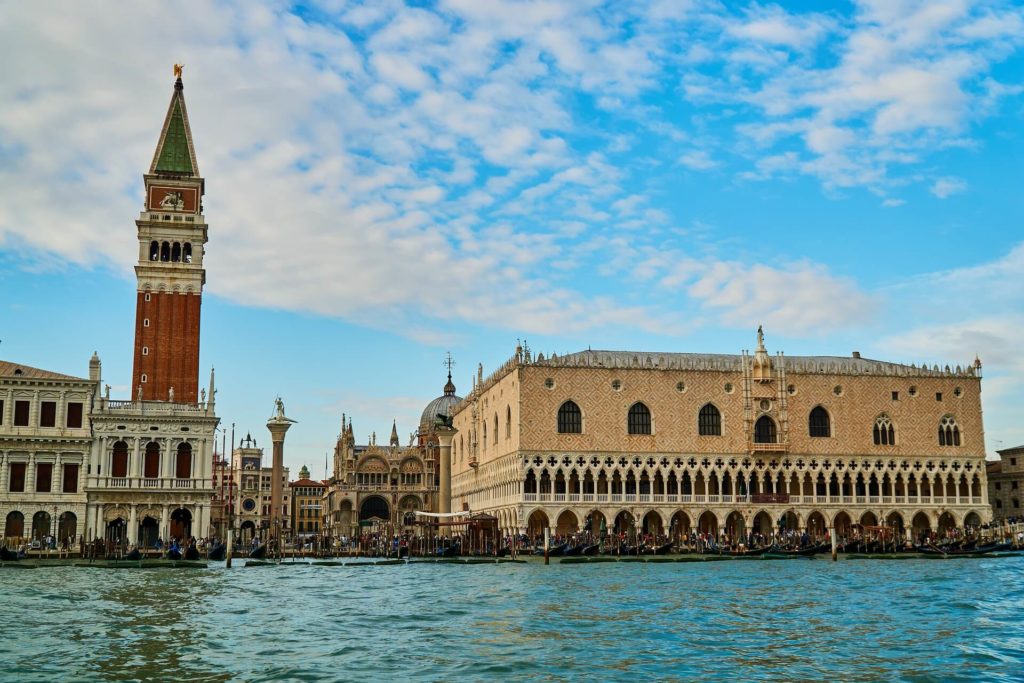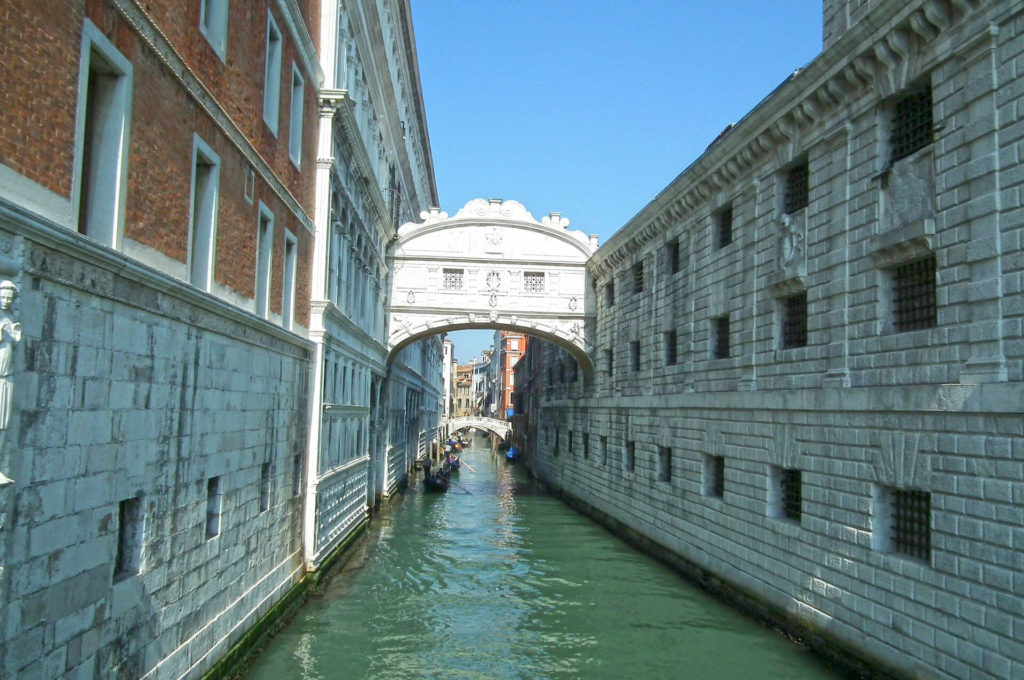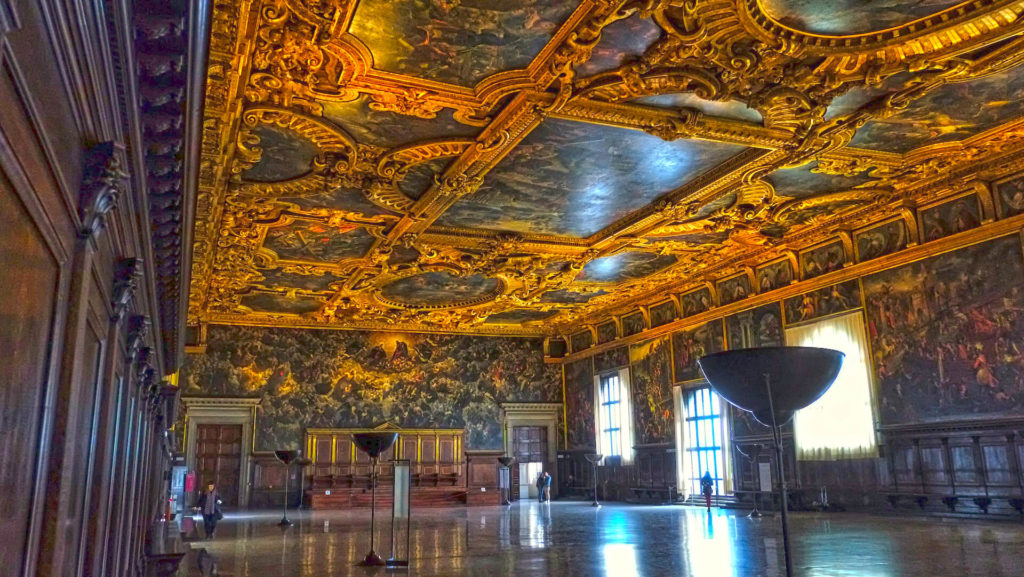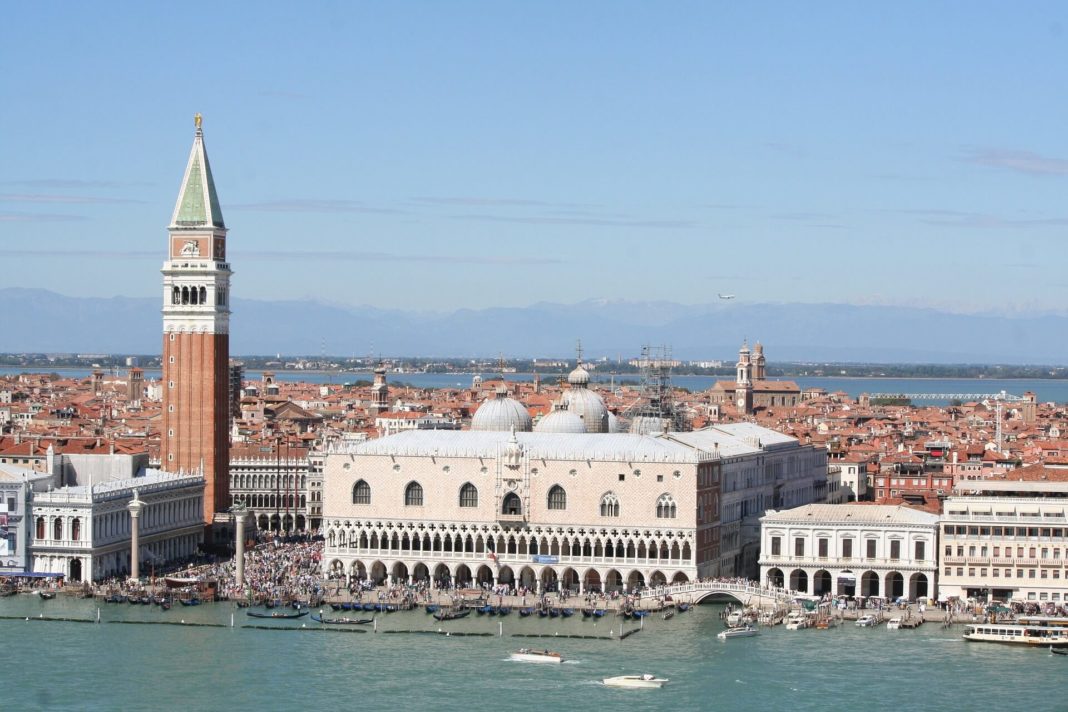Venice is a city full of beauty, history, and culture, and at the heart of it all lies the Doge’s Palace. This iconic building has stood for centuries as a symbol of Venetian power and prestige, and it continues to captivate visitors from around the world with its stunning architecture and fascinating exhibits. If you’re planning a trip to Venice and want to experience the best of what the Doge’s Palace has to offer, then you’ve come to the right place. In this guide, we’ll take you on a journey through the palace’s history, architecture, and art, exploring everything from the famous Bridge of Sighs to the opulent Sala del Maggior Consiglio. So grab your map, put on your walking shoes, and get ready to discover the wonders of the Doge’s Palace in Venice.
History of the Doge’s Palace
The Doge’s Palace, also known as Palazzo Ducale, was the residence of the Doge of Venice, the highest elected official in the Venetian Republic. The palace was built in the 14th century and underwent several renovations and expansions over the years. It was the center of political power in Venice and was the site of important ceremonies, including the election of the Doge and the signing of treaties.
The palace also served as a prison, and the infamous Bridge of Sighs connected the palace to the prison cells. The bridge earned its name because prisoners would sigh as they crossed it, knowing that they were leaving behind the light and beauty of the palace for the darkness and despair of the prison.
The Doge’s Palace has a rich and fascinating history, with many stories and legends woven into its walls. It was damaged during World War II but has since been restored to its former glory, and today it is one of the most popular tourist attractions in Venice.
Architecture and Design of the Doge’s Palace
The Doge’s Palace is a masterpiece of Gothic architecture, with its intricate arches, delicate tracery, and ornate decoration. The palace was designed to impress and intimidate, with its grand facades and soaring towers. The main entrance, known as the Porta della Carta, is a stunning example of Venetian Gothic, with its elaborate arches and sculptures.
Inside the palace, visitors can admire the magnificent halls and chambers, including the Sala del Maggior Consiglio, the largest room in the palace, which was used for meetings of the Great Council. The room is adorned with exquisite frescoes and paintings, including the famous Paradise by Tintoretto.
The palace also features a number of courtyards and gardens, including the delightful Courtyard of the Oranges, which is filled with fragrant citrus trees and offers stunning views of the city.
The Famous Artwork of the Doge’s Palace
The Doge’s Palace is home to a vast collection of artwork, including paintings, sculptures, and decorative objects. Many of the works were commissioned by the Doges themselves and are a testament to the wealth and power of the Venetian Republic.
One of the most famous works in the palace is the Triumph of Venice by Veronese, a stunning fresco that covers the ceiling of the Sala del Maggior Consiglio. The painting depicts Venice as a triumphant goddess, surrounded by allegorical figures representing the virtues of the Republic.
Other notable works include the Four Tetrarchs, a sculpture that dates back to the 4th century and was looted from Constantinople during the Fourth Crusade, and the breathtaking ceiling paintings in the Chamber of the Council of Ten.
Visitors can also admire the ornate decorations and furnishings of the palace, including the intricate woodwork and delicate stucco decorations.
Major Attractions to Visit in the Doge’s Palace

The Doge’s Palace has many attractions to offer visitors, from the grand halls and chambers to the hidden passages and secret rooms.
One of the most popular attractions is the Bridge of Sighs, which connects the palace to the prison cells. Visitors can cross the bridge and imagine the despair of the prisoners who were taken from the light and beauty of the palace to the darkness and filth of the prison.
Another must-see attraction is the Armoury, which houses a vast collection of weapons and armor, including the helmets and breastplates worn by the Doges and their guards.
Visitors can also explore the palace’s secret passages and hidden rooms, including the secret archives and the secret passages used by the Council of Ten.
Porta della Carta
The Porta della Carta is a Renaissance-era gate located in Venice, Italy. The gate serves as the main entrance to the Doge’s Palace, a historic palace that was the residence of the Doge of Venice and the seat of the city’s government.
History
The Porta della Carta was built in the mid-15th century as part of the renovation of the Doge’s Palace. The gate was designed by Giovanni and Bartolomeo Bon, and it served as the main entrance to the palace for visitors and dignitaries.
Architecture
The Porta della Carta is considered one of the finest examples of Renaissance architecture in Venice. The gate features a range of decorative elements, including sculptures, reliefs, and intricate carvings. The gate is also adorned with a range of symbols and emblems that represent the power and prestige of the Venetian Republic.
Visiting
The Porta della Carta is open to visitors as part of the Doge’s Palace. Visitors can explore the palace’s beautiful interior, including its opulent halls, stunning artwork, and historic collections. The palace also offers stunning views of Venice’s famous Grand Canal and St. Mark’s Square.
Bridge of Sighs

The Bridge of Sighs is a famous bridge located in Venice, Italy. The bridge connects the Doge’s Palace to the adjacent prison, and it is known for its beautiful architecture, historic significance, and romantic legend.
History
The Bridge of Sighs was built in the early 17th century as part of the renovation of the Doge’s Palace. The bridge was designed by Antonio Contino, and it served as a covered passageway that allowed prisoners to be transported from the palace to the prison without being seen by the public.
Architecture
The Bridge of Sighs is considered one of the most beautiful bridges in Venice. The bridge is made of white limestone and features a range of decorative elements, including sculptures, carvings, and ornate windows. The bridge also features two small windows with stone bars that allow visitors to peer into the prison cells below.
Legend
The Bridge of Sighs is also famous for its romantic legend, which suggests that couples who kiss under the bridge at sunset will enjoy eternal love and happiness. The legend has become a popular tourist attraction, and visitors can often be seen kissing under the bridge in the hopes of finding true love.
Visiting
The Bridge of Sighs is open to visitors as part of the Doge’s Palace. Visitors can cross the bridge and explore the prison cells below, as well as the palace’s opulent halls, stunning artwork, and historic collections. The palace also offers stunning views of Venice’s famous Grand Canal and St. Mark’s Square.
Foscari Arch and Scala dei Giganti
The Foscari Arch and Scala dei Giganti are two historic landmarks located in Venice, Italy. The arch and staircase are part of the Doge’s Palace, a historic palace that was the residence of the Doge of Venice and the seat of the city’s government.
Foscari Arch
The Foscari Arch is a stunning Renaissance-era archway that serves as the main entrance to the Doge’s Palace. The arch was built in the early 15th century and is known for its beautiful Gothic and Renaissance-style architecture. The arch features a range of decorative elements, including sculptures, carvings, and intricate details that represent the power and prestige of the Venetian Republic.
Scala dei Giganti
The Scala dei Giganti, or “Staircase of the Giants,” is a grand staircase located inside the Doge’s Palace that leads to the palace’s first floor. The staircase is named for the two massive statues of Neptune and Mars that flank the entrance, which are believed to represent the power and strength of the Venetian Republic. The staircase is considered one of the finest examples of Renaissance architecture in Venice and is known for its impressive size, ornate design, and beautiful artwork.
Visiting
The Foscari Arch and Scala dei Giganti are open to visitors as part of the Doge’s Palace. Visitors can explore the palace’s beautiful interior, including its opulent halls, stunning artwork, and historic collections. The palace also offers stunning views of Venice’s famous Grand Canal and St. Mark’s Square.
Tours of the Interior

Tours of the interior of the Doge’s Palace in Venice are a popular attraction for visitors to the city. The palace served as the residence of the Doge of Venice and the seat of the city’s government, and today it is a museum that offers a fascinating glimpse into the history and culture of Venice.
Guided tours of the palace’s interior are available and can provide visitors with a deeper understanding of the palace’s rich history and artistic treasures. These tours typically include a visit to the palace’s opulent halls, stunning artwork, and historic collections, as well as an exploration of its architecture and decorative elements.
Some of the highlights of a tour of the interior of the Doge’s Palace include:
- The Grand Staircase: This ornate staircase leads up to the palace’s upper floors and is adorned with stunning artwork and intricate carvings.
- The Council Chambers: These opulent halls were used for important government meetings and feature beautiful artwork, including frescoes by Tintoretto.
- The Doge’s Apartments: These private chambers were the residence of the Doge of Venice and feature stunning artwork and luxurious furnishings.
- The Prisons: The palace’s lower levels were used as a prison, and visitors can explore the cells and learn about the history of the prisoners who were held there.
Sala del Maggior Consiglio
The Sala del Maggior Consiglio, or the Hall of the Great Council, is a historic hall located in the Doge’s Palace in Venice, Italy. The hall is one of the largest rooms in the palace and was the site of many important government meetings during the time of the Venetian Republic.
History
The Sala del Maggior Consiglio was originally built in the 14th century and was the site of the Great Council, which was the legislative body of the Venetian Republic. The hall was used for important government meetings, including the election of the Doge and the approval of new laws and policies.
Architecture
The Sala del Maggior Consiglio is known for its impressive size and ornate design. The hall is adorned with stunning artwork and decorative elements, including intricate carvings, frescoes, and gilded ceilings. The hall also features a raised platform at one end, where the Doge would sit during meetings.
Artwork
The Sala del Maggior Consiglio is home to several important works of art, including the massive painting “Paradise” by Tintoretto, which is one of the largest oil paintings in the world. The painting depicts the final judgement of humanity and is considered one of Tintoretto’s greatest masterpieces.
Visiting
The Sala del Maggior Consiglio is open to visitors as part of the Doge’s Palace. Guided tours of the palace’s interior are available, and visitors can explore the hall’s impressive architecture, artwork, and historic significance.
Scala d’Oro
The Scala d’Oro, or the Golden Staircase, is a historic staircase located in the Doge’s Palace in Venice, Italy. The staircase is known for its beautiful architecture and impressive design, and it has played an important role in the history and culture of Venice.
History
The Scala d’Oro was built in the 16th century and was originally used as a private staircase for the Doge of Venice. The staircase was designed by Antonio Rizzo, and it is known for its beautiful Renaissance-style architecture.
Architecture
The Scala d’Oro is considered one of the finest examples of Renaissance architecture in Venice. The staircase is made of white marble and features a range of decorative elements, including sculptures, carvings, and intricate details. The staircase is also adorned with a range of symbols and emblems that represent the power and prestige of the Venetian Republic.
Visiting
The Scala d’Oro is open to visitors as part of the Doge’s Palace. Guided tours of the palace’s interior are available, and visitors can explore the staircase’s impressive architecture and historic significance.
Sala del Collegio and Sala del Senato
The Sala del Collegio and Sala del Senato are two historic rooms located in the Doge’s Palace in Venice, Italy. The rooms served as important centers of government and administration during the time of the Venetian Republic, and today they offer visitors a fascinating glimpse into the history and culture of Venice.
Sala del Collegio
The Sala del Collegio, or the Hall of the College, is a stunning room located in the Doge’s Palace that was used for meetings of the Collegio, which was the executive branch of the Venetian government. The room is known for its impressive artwork and architecture, including a beautiful ceiling painting by Veronese that depicts Venice as the center of the world.
Sala del Senato
The Sala del Senato, or the Hall of the Senate, is another important room located in the Doge’s Palace that was used for meetings of the Senate, which was the legislative branch of the Venetian government. The room is known for its stunning artwork and architecture, including a beautiful ceiling painting by Tintoretto that depicts the triumph of Venice over its enemies.
Visiting
The Sala del Collegio and Sala del Senato are open to visitors as part of the Doge’s Palace. Guided tours of the palace’s interior are available, and visitors can explore the rooms’ impressive architecture, artwork, and historic significance.
Sala del Consiglio dei Dieci
The Sala del Consiglio dei Dieci, or the Council Chamber of the Ten, is a historic room located in the Doge’s Palace in Venice, Italy. The room served as the meeting place of the Council of Ten, which was a powerful committee that played an important role in the government of the Venetian Republic.
History
The Sala del Consiglio dei Dieci was built in the 16th century and was used for meetings of the Council of Ten, which was responsible for matters of state security, espionage, and foreign affairs. The council was known for its powerful influence in the Venetian government, and its meetings were held in strict secrecy.
Architecture
The Sala del Consiglio dei Dieci is known for its beautiful architecture and ornate design. The room features a range of decorative elements, including sculptures, carvings, and intricate details. The room is also adorned with a range of symbols and emblems that represent the power and prestige of the Venetian Republic.
Artwork
The Sala del Consiglio dei Dieci is home to several important works of art, including a large painting by Jacopo Tintoretto that depicts the council members in session. The painting is considered one of Tintoretto’s greatest masterpieces and is a testament to the importance of the Council of Ten in Venetian history.
Visiting
The Sala del Consiglio dei Dieci is open to visitors as part of the Doge’s Palace. Guided tours of the palace’s interior are available, and visitors can explore the room’s impressive architecture, artwork, and historic significance.
Doge’s Palace Apartments
The Doge’s Palace Apartments are a set of private chambers located within the Doge’s Palace in Venice, Italy. The apartments served as the residence of the Doge of Venice and his family during the time of the Venetian Republic, and today they offer visitors a glimpse into the opulent lifestyle of the Venetian aristocracy.
History
The Doge’s Palace Apartments were built in the 16th century and were used as the private chambers of the Doge of Venice and his family. The apartments are known for their opulent design and luxurious furnishings, including intricate carvings, frescoes, and gilded decorations.
Architecture
The Doge’s Palace Apartments are considered some of the finest examples of Renaissance architecture in Venice. The apartments feature a range of decorative elements, including sculptures, carvings, and intricate details that represent the power and prestige of the Venetian Republic.
Artwork
The Doge’s Palace Apartments are home to several important works of art, including paintings by artists such as Tintoretto and Veronese. The artwork depicts a range of scenes from Venetian history and offers a glimpse into the artistic and cultural legacy of Venice.
Visiting
The Doge’s Palace Apartments are open to visitors as part of the Doge’s Palace. Guided tours of the palace’s interior are available, and visitors can explore the apartments’ impressive architecture, artwork, and historic significance.
Prigioni (Prisons)
The Prigioni, or Prisons, are a set of historic prison cells located in the lower levels of the Doge’s Palace in Venice, Italy. The prisons served as a detention center for prisoners during the time of the Venetian Republic, and today they offer visitors a glimpse into the harsh realities of prison life during that time period.
History
The Prigioni were built in the 16th century and were used as a prison for a wide range of offenders, including political prisoners, common criminals, and prisoners of war. The prisons were known for their harsh conditions, with prisoners often being held in small, cramped cells without access to sunlight or fresh air.
Architecture
The Prigioni are known for their stark and foreboding design. The prison cells are small and cramped, with little decoration or ornamentation. The cells are also arranged in a complex and confusing layout, which was designed to disorient prisoners and make it difficult for them to escape.
Visiting
The Prigioni are open to visitors as part of the Doge’s Palace. Guided tours of the palace’s interior are available, and visitors can explore the prisons’ stark architecture and historic significance. Some of the most famous prisoners held in the Prigioni include the adventurer Giacomo Casanova and the writer and philosopher Antonio Gramsci.
Armory
The Armory is a historic room located within the Doge’s Palace in Venice, Italy. The armory was once used as a storage space for weapons and armor during the time of the Venetian Republic, and today it houses a collection of historic arms and armor that offer a glimpse into the military history of Venice.
History
The Armory was built in the 16th century and was used as a storage space for weapons and armor. During its time as an active armory, the room was used to store a wide range of military equipment, including swords, shields, and firearms.
Exhibits
Today, the Armory is home to a collection of historic arms and armor that offer a fascinating glimpse into the military history of Venice. The collection includes a range of weapons and armor from the 15th through the 18th centuries, as well as a selection of firearms and other military equipment.
Visiting
The Armory is open to visitors as part of the Doge’s Palace. Guided tours of the palace’s interior are available, and visitors can explore the armory’s impressive collection of weapons and armor, as well as learn about the military history of Venice.
Tips for Visiting the Doge’s Palace
Visiting the Doge’s Palace can be an overwhelming experience, with so much to see and explore. Here are some tips to help you make the most of your visit:
- Buy tickets in advance to avoid long lines.
- Wear comfortable shoes, as there is a lot of walking involved.
- Consider hiring a guide to learn more about the history and art of the palace.
- Bring a camera to capture the stunning architecture and artwork.
- Be respectful of the palace’s rules and regulations, including dress codes and photography restrictions.
How to Get to the Doge’s Palace
The Doge’s Palace is located in the heart of Venice, just a short walk from St. Mark’s Square. Visitors can reach the palace by water taxi, vaporetto, or on foot. The nearest vaporetto stop is San Zaccaria, and there are several water taxi stops nearby. If you’re walking, follow the signs to St. Mark’s Square, and the palace is located just off the square.
Best Time to Visit the Doge’s Palace
The Doge’s Palace is open year-round, but the best time to visit depends on your preferences. If you want to avoid the crowds, visit in the early morning or late afternoon. If you want to experience the palace’s grandeur and opulence, visit during the day when the sunlight streams through the windows and illuminates the artwork and decoration.
Interesting Facts about the Doge’s Palace
- The palace was damaged during World War II but has since been restored to its former glory.
- The Bridge of Sighs earned its name because prisoners would sigh as they crossed it, knowing that they were leaving behind the light and beauty of the palace for the darkness and despair of the prison.
- The palace was used as a setting for several films, including Casino Royale and The Tourist.
- The palace is home to a vast collection of artwork, including paintings, sculptures, and decorative objects.
- The palace was the center of political power in Venice and was the site of important ceremonies, including the election of the Doge and the signing of treaties.
Where to Stay near the Doge’s Palace
One great option is the Hotel Danieli, which is located just a short walk from the Doge’s Palace. This luxurious hotel offers stunning views of the city and is the perfect place to relax after a busy day of sightseeing. With its elegant decor, impeccable service, and top-notch amenities, the Hotel Danieli is sure to make your stay in Venice unforgettable.
Another great option is the Hotel Londra Palace, which is located right on the waterfront and offers breathtaking views of the lagoon. This historic hotel has been welcoming guests for over 150 years and is known for its elegant atmosphere and impeccable service. With its prime location and luxurious amenities, the Hotel Londra Palace is the perfect choice for anyone looking to stay near the Doge’s Palace.
If you’re looking for something a bit more budget-friendly, there are plenty of options in the area as well. The Hotel Al Codega is a great choice for anyone looking for comfortable accommodation at an affordable price. This cozy hotel is located just a short walk from the Doge’s Palace and offers clean, comfortable rooms and friendly service.
No matter what your budget or preferences, there are plenty of great options for where to stay near the Doge’s Palace. Whether you’re looking for luxury or affordability, you’re sure to find the perfect accommodation in this vibrant and historic part of Venice. So why wait? Book your stay today and get ready to experience all that this incredible city has to offer!












